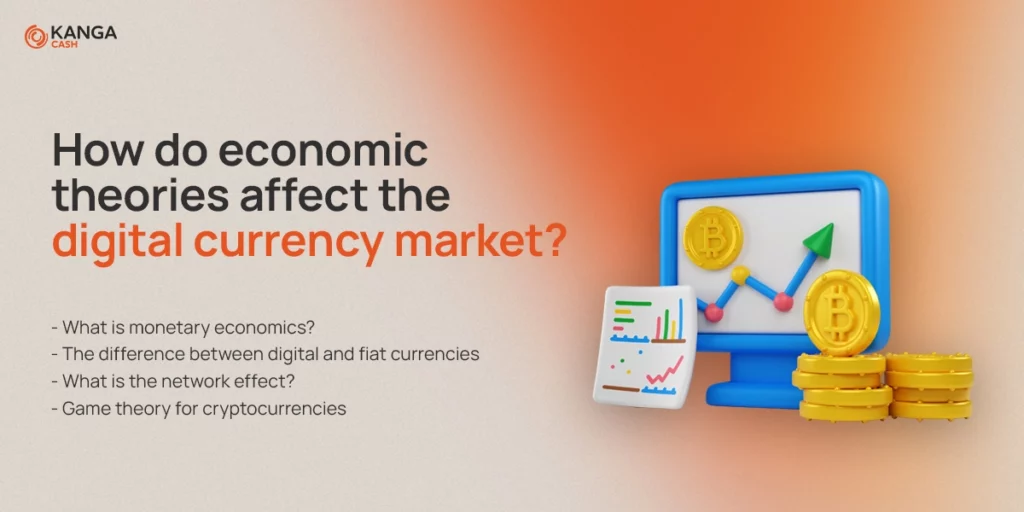How do economic theories affect the digital currency market?

We take money for granted. Well, people collectively recognized them as a means of exchange, a kind of measure of value. At the same time, we are talking about money in the traditional sense of the word. In the case of cryptocurrencies, the situation is quite different.
For people familiar with the digital currency market, or at least trying to understand it, it is not difficult to figure out the reasons behind why even bitcoin is worth so much money. “Outsiders” look at cryptocurrencies and 1) are surprised by their economic potential, and at the same time 2) are stuck in their belief that they are just a novelty, a “financial fad” that will disappear as quickly as it appeared. And since they treat the topic as part of fashion, they don’t feel obligated to delve into the subject.
Cryptocurrencies were, are and will be. Even if at some point they change their format, the idea behind it will not change, and that is to restore people’s monetary freedom.
Without getting too idealistic, however, trying to understand such a seemingly mundane thing as money is never a waste of time. What is more, getting to know them better may become a contribution to realizing the meanders of today’s economy. We stop using them mechanically and start thinking about them. This is the only way we can find a way to multiply them.
It is similar in the case of crypto. No one will make money in the cryptocurrency market if they do not make an effort to understand it. These things obviously come together as economics, and more specifically economic theories, have an impact on digital assets. How? You will learn more soon!
What is monetary ecomonics?
Monetary economics, also known as monetarism, is a school of economics whose leading representatives are Milton Friedman, Anna Schwartz, Karl Brunner, Allan Meltzer, David Laidler, Michael Parkin and Alan Walters. Monetarists developed a proprietary approach to macroeconomic policy, in contrast to over-reliance on fiscal policy.
The main interest of monetarists is the study of the impact of monetary policy on national income, emphasizing both the neutrality of money in the long run and its lack of neutrality in the short run, and the difference between nominal and real interest rates. This school is characterized by a deep conviction in the power of self-regulating market mechanisms.
According to monetarists, the main goal of monetary policy should be to control the money supply. This means moving away from fixed exchange rates, which are insufficient to control the money supply in an open economy. Under such conditions, only the size of credit can be regulated, but not the money supply. Monetarists believe that the government can control the nominal interest rate and that the real rate depends on the expected rate of inflation.
The difference between digital and fiat currencies
To begin with, the three main functions of a fiat currency are as a medium of exchange, a store of value, and a unit of account. At first glance, fiat and crypto do not differ from each other, because regardless of the selected currency, we are able to buy something of a certain value with it.
However, the devil is in the details, and more specifically – in decentralization. Traditional money is regulated and controlled by financial institutions. Cryptocurrency operates in a decentralized environment with no central point of power.
Many people make the mistake of focusing on blockchain technology only as an IT or cryptographic solution. The answers to the key challenges of new technology require thinking from an economic perspective. In no way can economic science be underestimated, hoping that the principles behind digital currencies will not benefit from it.
We do not know the answer to the question of when cryptocurrencies will become a widely accepted universal payment tool. Considering that significant changes take time, it is in vain to count on immediate changes in this regard. There is a lot of talk about “cryptocurrencies will destroy the system”, and in fact digital assets depend on this system. It is better to think in this context of slow evolution rather than sudden revolution.
What is the network effect?
The network effect is a key economic phenomenon where a product or service increases in value as the number of users increases. Each new user entering the network adds value to the product, which in turn attracts more people (investors, so to speak), causing a further increase in value. This process is exponential because it grows as more and more people accumulate.
Cryptocurrencies are one of the best-known examples of the network effect. In the beginning, when only a small number of people had them, the benefits of having them were limited. However, as the number of investors increased, the digital currency became more useful and valuable. The network effect has driven the expansion of blockchain technology, leading to its widespread adoption.
You can also look at it another way. Acquiring crypto is not possible without first having fiat money. The more we have, the more cryptocurrencies we are able to purchase.
Game theory for cryptocurrencies
Game theory is a branch of applied mathematics that analyzes situations in which different players participate and their decisions influence each other. Interdependence means that each player must take into account the possible moves and strategies of other players in order to work out the optimal strategy for himself.
In game theory, various models and mathematical tools are used to analyze such situations. Games can be conflicting, cooperative, or mixed, and players’ goals can be compatible or conflicting. Different scenarios that can happen in the game are considered, and the results that can result from different strategies.
Cryptography and game theory correlate to create consensus mechanisms to ensure network integrity and security.
Nodes in the Bitcoin system, scattered across different locations, must operate on the basis of consent, despite the lack of mutual trust. A consensus mechanism such as Proof-of-Work contributes to the integrity of the nodes as it requires an expensive and demanding mining process that is conducted in a competitive environment. This makes malicious or fraudulent activities difficult and unprofitable, encouraging nodes to act honestly.
The concept of cryptoeconomics, which resulted from the use of game theory in the world of cryptocurrencies, studies the behavior of nodes based on the benefits offered by the protocol. Nodes make final decisions, guided by the most likely and optimal choices that result from the application of cryptoeconomic rules and mechanisms in the blockchain network.
Summary
As you can see, economic theories also apply in the world of cryptocurrencies, and many of the market rules and mechanisms that we observe in traditional financial markets are also found in the digital currency market.
Cryptocurrencies, as a decentralized ecosystem, have been subject to investments, various market phases and speculations, just like traditional assets. We also often see similar patterns of behavior and reaction to changing market conditions. This shows that the fundamental laws of economics still apply in the world of cryptocurrencies.
Understanding the financial and economic fundamentals can help investors better understand how the cryptocurrency market works and make more informed investment decisions. It is worth emphasizing, however, that the cryptocurrency market is unique and has specific features that require careful analysis and decision-making.
Thank you for reading! For people who have arrived here, we have prepared the code “EKONOMIA” reducing the transaction in exchange offices by 0.25% (valid until August 7!).


